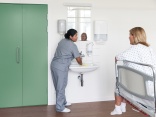Home › magazine › february march 2025 › latest news › Hygiene in healthcare winter woes
Hygiene in healthcare - winter woes
25th of March 2025What are the biggest problems that hospitals have to face in winter in terms of cleaning and hygiene? Ann Laffeaty finds out.
February and March are challenging months for the European healthcare sector. Winter is when we see greater numbers of cold, flu and norovirus outbreaks in the northern hemisphere. Cold weather also leads to more people congregating inside where they become susceptible to any infection or virus that happens to be going around. Other issues such as staff shortages, new Covid variants and budget restraints only add to these “winter woes” in healthcare. And during the closing months of winter, healthcare staff will be exhausted from having to cope with higher patient loads.
So, what are the biggest problems for hospitals during the winter months, and how do cleaning companies and manufacturers go about addressing them?
The spread of germs and microorganisms is a major issue at this time of year, says Kärcher’s cleaning solutions consultant Gundula Braun. “People in hospital will be congregating in a small or confined area, many of whom will be ill and possibly also pathogen-spreaders,” she said. “On top of this, the indoor air will be dryer than usual due to the rooms being heated. And this air is also likely to be contaminated with pathogens.
“The primary challenge for staff will be to adhere to strict cleaning and hygiene procedures to ensure that winter germs are not allowed to spread further.”
Limited staff capacities and budget constraints make this process more difficult, she says. “These factors will lead to cost-cutting measures across the whole hospital environment, not just in cleaning.
“However, the extent to which cleaning is affected will depend on the cost-cutting priorities of the facility, and also on whether or not cleaning services are outsourced or handled in-house. And if cleaning measures are to be cut, this will influence the agreement with the service provider and be subject to approval from hygiene experts in the hospital.”
Staff shortages and long waiting lists can put pressure on healthcare personnel to cut corners, she says. “However, cleaning and hygiene measures are defined by the hospital’s hygiene experts and must be strictly followed even during busy periods,” said Braun.
“Instead of cutting corners it makes more sense to reduce those cleaning activities that add no value. So any activity that does not create a clean environment should be identified and either reduced or eliminated.”
The inevitable winter spike in viruses and infections should increase vigilance as far as cleaning measures are concerned, she said. “In the case of highly contagious infections such as norovirus or MRSA, strict hygiene protocols will be in place and these will always take effect in case of an outbreak,” said Braun.
Most of the common “winter woes” can be combatted by a combination of machines, detergents and manual tools, according to Braun. Kärcher offers a range of scrubber dryers, sweepers, autonomous cleaning solutions, steam cleaners and air purifiers designed to help achieve a hygienic clean in hospitals.
Recruiting sufficient staff to ensure all departments are cleaned according to proper methods remains a major challenge, says Greenspeed marketing executive Rosaliene Verhoef. “Hospitals are often forced to make last-minute decisions that involve cleaning multiple departments using a reduced weekend schedule, which is driven by a high absentee rate on any given day.
“Meanwhile, the growing threat of multi-resistant bacteria remains a pressing concern,” she adds. “This issue is largely fuelled by the overuse - and sometimes unnecessary use - of antibiotics combined with improper or excessive surface disinfection. These practices create conditions that will encourage the development of resistant strains, making infection control increasingly difficult.”
However, the primary difficulty today is in maintaining a skilled and consistent workforce when budgets are tight, Verhoef says. “The evolution of mechanised cleaning methods is helping to improve efficiency and reduce labour costs, but human expertise is crucial for thorough cleaning and hygiene.”
Training continues to play a vital role in healthcare, she adds. “However, training will only prove to be effective if the cleaning team remains stable,” she says. “A high turnover of staff will undermine efforts to build a well-trained workforce because new hires may require repeated instruction, delaying progress and consistency.”
Hospitals are increasingly opting to clean several departments using a reduced, weekend-level cleaning schedule because of staff shortages, according to Verhoef. “While this approach may ensure minimal operational hygiene, it also compromises thoroughness,” she said.
“Hand hygiene must never be neglected. Both nursing staff and cleaning teams should prioritise proper hand washing and hand disinfection. This is a critical barrier against the spread of infections, even in times when resources are restricted.”
A spike in infections from seasonal illnesses such as Covid, influenza, norovirus, or MRSA is almost inevitable over winter, Verhoef continues. “In response, it is hoped that hospitals will place renewed emphasis on hand hygiene. This includes not just hand washing but also proper disinfection before performing medical procedures or handling patients. Reinforcing these protocols can significantly reduce transmission risks in clinical settings.”
Greenspeed advocates the use of probiotic cleaners instead of preventive disinfection products. “Probiotic cleaners work to restore and maintain a healthy microbial balance on surfaces, whereas over-disinfecting can create resistant strains,” said Verhoef. “Surfaces should only be disinfected when necessary.”
Ongoing staff shortages and the persistent threat of illness all combine to strain healthcare resources during the winter, says Essity communications director Jenny Turner. “Winter illnesses lead to heavier patient loads and staff shortages which increase the challenge of maintaining rigorous cleaning protocols,” she said.
“Budget constraints are a significant issue because limited financial resources can impact on essential tasks such as equipment cleaning and training staff. Without adequate funding it becomes difficult to invest in the latest cleaning technologies and provide comprehensive training for staff. And these elements are crucial for maintaining high hygiene standards.”
Staff shortages and long waiting lists place significant pressure on healthcare facilities, she says. “This makes it more challenging to maintain routines and protocols,” said Turner. “In such circumstances it can be difficult to ensure all surfaces are thoroughly cleaned and that hand hygiene routines are strictly followed. However, healthcare establishments must prioritise hygiene and overall cleanliness to minimise the risk of infections, even under these tricky conditions.”
An increase in patient numbers could lead to the mental and physical fatigue of healthcare workers, says Turner. “This could potentially impact their ability to maintain high standards of cleanliness and hygiene,” she said.
A spike in infections is a risk each winter. “In response, healthcare facilities are likely to intensify their hand washing and cleaning protocols,” said Turner. “This includes more frequent cleaning of high-touch surfaces, increased availability of hand soaps and sanitisers and reinforcing the importance of good hand hygiene practices among staff, patients and visitors.”
Tork offers a range of cleaning and hygiene solutions including Tork PeakServe Continuous Hand Towel dispensers which provide touch-free dispensing to minimise cross-contamination. Essity also provides hand hygiene and surface cleaning training for healthcare staff.
Inadequate healthcare budgets during the winter can compromise high hygiene standards, says Filmop’s business development manager Paolo Scapinello. “It is necessary to remember any initial investment pays off over time,” he said. “A high level of hygiene significantly reduces the costs resulting from infections contracted during hospitalisation, which can be avoided by implementing correct prevention procedures.”
He says a co-circulation of winter viruses occurs every winter. “Influenza is one of the viruses that circulates most widely in EU countries causing seasonal epidemics, while Covid tends to be year-round,” he said. “And norovirus continues to be widespread in winter while MRSA remains one of the main causes of care-related infections requiring year-round attention.”
Severe winter illnesses can contribute to hospital saturation, says Scapinello. “Effective cleaning and proper hand hygiene are essential for prevention purposes and should be pursued at all times, regardless of seasonality,” he said. “However, the increased incidence of infections and viruses in winter means practices and procedures need to be even more stringent to protect the health of the community and safeguard the most vulnerable.”
Filmop’s A-B Plus system of trolleys, mop holders and mops are treated with antibacterial additives to protect them against bacteria, fungi and mould. The company also offers touch-free stands equipped with an optical sensor or foot pedal designed to make disinfectant dispensing more accessible.
So, what solutions do commentators offer that can address some of the most common “winter woes”?
Improved ventilation can help reduce the spread of infections, says Gundula Braun. “Poor weather conditions lead to people spending more time indoors with all the doors and windows closed,” she said. “The risk of catching air-transmitted pathogens increases when people gather together inside rooms that are not well-ventilated.”
Another prominent issue is the improper and inconsistent disinfection of surfaces, says Greenspeed’s Rosaliene Verhoef. “In many cases, disinfection is performed without sufficient attention to dosage or contact time – and this reduces its effectiveness,” she said. “Thorough cleaning with microfibre is often more effective than poorly executed disinfection.”
And a careful choice of hand hygiene products can address the problem of sore, chapped hands that often occurs in winter, says Essity’s Jenny Turner. “Chapped hands caused by frequent hand washing in cold weather can be unpleasant for healthcare staff and may also spread infections,” she said. “Therefore, soaps that are mild and effective coupled with soft, high quality paper towels will encourage more people to wash hands effectively.”










